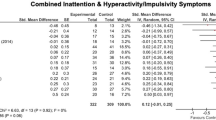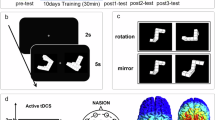Abstract
There is an increasing interest in non-pharmacological treatments for children with attention-deficit/hyperactivity disorder (AD/HD), especially digital techniques that can be remotely delivered, such as neurofeedback (NFT) and computerized cognitive training (CCT). In this study, a randomized controlled design was used to compare training outcomes between remotely delivered NFT, CCT, and combined NFT/CCT training approaches. A total of 121 children with AD/HD were randomly assigned to the NFT, CCT, or NFT/CCT training groups, with 80 children completing the training program. Pre- and post-training symptoms (primary outcome), executive and daily functions were measured using questionnaires as well as resting EEG during eyes-closed (EC) and eyes-open (EO) conditions. After 3 months of training, the inattentive and hyperactive/impulsive symptoms, inhibition, working memory, learning and life skills of the three groups of children were significantly improved. The objective EEG activity showed a consistent increase in the relative alpha power in the EO condition among the three training groups. Training differences were not observed between groups. There was a positive correlation between pre-training EO relative alpha power and symptom improvement scores of inattention and hyperactivity/impulsivity, as well as a negative correlation between pre-training inattention scores and change in EO relative alpha. This study verified the training effects of NFT, CCT, and combined NFT/CCT training in children with AD/HD and revealed an objective therapeutic role for individual relative alpha activity. The verified feasibility and effectiveness of home-based digital training support promotion and application of digital remote training.




Similar content being viewed by others
References
Barkley RA (1997) Behavioral inhibition, sustained attention, and executive functions: constructing a unifying theory of ADHD. Psychol Bull 121:65–94
Sonuga-Barke E (2003) The dual pathway model of AD/HD: an elaboration of neuro-developmental characteristics. Neurosci Biobehav Rev 27:593–604
Barbaresi WJ, Katusic SK, Colligan RC, Weaver AL, Leibson CL, Jacobsen SJ (2014) Long-term stimulant medication treatment of attention-deficit/hyperactivity disorder: results from a population-based study. J Dev Behav Pediatr 35:448–457
Enriquez-Geppert S, Smit D, Pimenta MG, Arns M (2019) Neurofeedback as a treatment intervention in ADHD: current evidence and practice. Curr Psychiatry Rep 21:46
Barry RJ, Clarke AR, Johnstone SJ (2003) A review of electrophysiology in attention-deficit/hyperactivity disorder: I. Qualitative and quantitative electroencephalography. Clin Neurophysiol 114:171–183
Byeon J, Choi TY, Won GH, Lee J, Kim JW (2020) A novel quantitative electroencephalography subtype with high alpha power in ADHD: ADHD or misdiagnosed ADHD? PLoS ONE 15:e0242566
Buyck I, Wiersema JR (2014) Resting electroencephalogram in attention deficit hyperactivity disorder: developmental course and diagnostic value. Psychiatry Res 216:391–397
Loo SK, Cho A, Hale TS, McGough J, McCracken J, Smalley SL (2013) Characterization of the theta to beta ratio in ADHD: identifying potential sources of heterogeneity. J Atten Disord 17:384–392
Zhang DW, Li H, Wu Z, Zhao Q, Song Y, Liu L et al (2019) Electroencephalogram theta/beta ratio and spectral power correlates of executive functions in children and adolescents with AD/HD. J Atten Disord 23:721–732
Zhang DW, Johnstone SJ, Roodenrys S, Luo X, Li H, Wang E et al (2018) The role of resting-state EEG localized activation and central nervous system arousal in executive function performance in children with attention-deficit/hyperactivity disorder. Clin Neurophysiol 129:1192–1200
Zhang DW, Roodenrys S, Li H, Barry RJ, Clarke AR, Wu Z et al (2017) Atypical interference control in children with AD/HD with elevated theta/beta ratio. Biol Psychol 128:82–88
Albrecht B, Uebel-von Sandersleben H, Gevensleben H, Rothenberger A (2015) Pathophysiology of ADHD and associated problems—starting points for NF interventions? Front Hum Neurosci 9:359
Arnold LE, Arns M, Barterian J, Bergman R, Black S, Conners CK et al (2021) Double-blind placebo-controlled randomized clinical trial of neurofeedback for attention-deficit/hyperactivity disorder with 13-month follow-up. J Am Acad Child Adolesc Psychiatry 60:841–855
Jurigova BG, Gerdes MR, Anguera JA, Marco EJ (2021) Sustained benefits of cognitive training in children with inattention, three-year follow-up. PLoS ONE 16:e0246449
Van Doren J, Arns M, Heinrich H, Vollebregt MA, Strehl U, Loo K, S, (2019) Sustained effects of neurofeedback in ADHD: a systematic review and meta-analysis. Eur Child Adolesc Psychiatry 28:293–305
Arns M, Clark CR, Trullinger M, DeBeus R, Mack M, Aniftos M (2020) Neurofeedback and attention-deficit/hyperactivity-disorder (ADHD) in children: rating the evidence and proposed guidelines. Appl Psychophysiol Biofeedback 45:39–48
Keshavan MS, Vinogradov S, Rumsey J, Sherrill J, Wagner A (2014) Cognitive training in mental disorders: update and future directions. Am J Psychiatry 171:510–522
Mirabella G (2021) Inhibitory control and impulsive responses in neurodevelopmental disorders. Dev Med Child Neurol 63:520–526
Cortese S, Kelly C, Chabernaud C, Proal E, Di Martino A, Milham MP, Castellanos FX (2012) Toward systems neuroscience of ADHD: a meta-analysis of 55 fMRI studies. Am J Psychiatry 169:1038–1055
Sonuga-Barke E, Brandeis D, Holtmann M, Cortese S (2014) Computer-based cognitive training for ADHD. A review of current evidence. Child Adolesc Psychiatr Clin N Am 23:807–824
Hoekzema E, Carmona S, Tremols V, Gispert JD, Guitart M, Fauquet J et al (2010) Enhanced neural activity in frontal and cerebellar circuits after cognitive training in children with attention-deficit/hyperactivity disorder. Hum Brain Mapp 31:1942–1950
Wang X, Covey TJ (2020) Neurophysiological indices of the transfer of cognitive training gains to untrained tasks. Neurobiol Learn Mem 171:107205
Kollins SH, DeLoss DJ, Cañadas E, Lutz J, Findling RL, Keefe RSE et al (2020) A novel digital intervention for actively reducing severity of paediatric ADHD (STARS-ADHD): a randomised controlled trial. Lancet Digit Health 2:e168–e178
Pandian GSB, Jain A, Raza Q, Sahu KK (2021) Digital health interventions (DHI) for the treatment of attention deficit hyperactivity disorder (ADHD) in children—a comparative review of literature among various treatment and DHI. Psychiatry Res 297:113742
Jeon JY, Kim H, Yu KS (2020) The impact of COVID-19 on the conduct of clinical trials for medical products in Korea. J Korean Med Sci 35:e329
Camargo CP, Tempski PZ, Busnardo FF, Martins MA, Gemperli R (2020) Online learning and COVID-19: a meta-synthesis analysis. Clin (Sao Paulo) 75:e2286
Wu H, Sun W, Huang X, Yu S, Wang H, Bi X et al (2020) Online antenatal care during the COVID-19 pandemic: opportunities and challenges. J Med Internet Res 22:e19916
Johnstone SJ (2013) Computer gaming and ADHD: potential positive influences on behavior [opinion]. IEEE Technol Soc Mag 32:20–22
Johnstone SJ, Roodenrys SJ, Johnson K, Bonfield R, Bennett SJ (2017) Game-based combined cognitive and neurofeedback training using Focus Pocus reduces symptom severity in children with diagnosed AD/HD and subclinical AD/HD. Int J Psychophysiol 116:32–44
Jiang H, Johnstone SJ, Sun L, Zhang DW (2021) Effect of neurocognitive training for children with ADHD at improving academic engagement in two learning settings. J Atten Disord 25:414–431
Rogers JM, Johnstone SJ, Aminov A, Donnelly J, Wilson PH (2016) Test-retest reliability of a single-channel, wireless EEG system. Int J Psychophysiol 106:87–96
Johnstone SJ, Blackman R, Bruggemann JM (2012) EEG from a single-channel dry-sensor recording device. Clin EEG Neurosci 43:112–120
Zhang DW, Johnstone SJ, Li H, Luo X, Sun L (2021) Comparing the transfer effects of three neurocognitive training protocols in children with attention-deficit/hyperactivity disorder: a single-case experimental design. Behav Change. https://doi.org/10.1017/bec.2021.26
Anguera JA, Boccanfuso J, Rintoul JL, Al-Hashimi O, Faraji F, Janowich J et al (2013) Video game training enhances cognitive control in older adults. Nature 501:97–101
Wan L, Huang H, Schwab N, Tanner J, Rajan A, Lam NB et al (2019) From eyes-closed to eyes-open: role of cholinergic projections in EC-to-EO alpha reactivity revealed by combining EEG and MRI. Hum Brain Mapp 40:566–577
Woltering S, Jung J, Liu Z, Tannock R (2012) Resting state EEG oscillatory power differences in ADHD college students and their peers. Behav Brain Funct 8:60
DuPaul GJ, Power TJ, Anastopoulos AD, Reid R (1998) ADHD rating scale-IV (for children and adolescents) checklists, norms, and clinical interpretation. Guilford Publications, New York
Gioia GA, Isquith PK, Guy SC, Kenworthy L, Baron IS (2000) Behavior rating inventory of executive function. Child Neuropsychol 6:235–238
Thompson T, Lloyd A, Joseph A, Weiss M (2017) The Weiss functional impairment rating scale-parent form for assessing ADHD: evaluating diagnostic accuracy and determining optimal thresholds using ROC analysis. Qual Life Res 26:1879–1885
Delorme A, Makeig S (2004) EEGLAB: An open source toolbox for analysis of single-trial EEG dynamics including independent component analysis. J Neurosci Methods 134:9–21
Shimoni M, Engel-Yeger B, Tirosh E (2012) Executive dysfunctions among boys with attention deficit hyperactivity disorder (ADHD): performance-based test and parents report. Res Dev Disabil 33:858–865
Spawton-Rice JH, Walker Z (2020) Do cognitive training applications improve executive function in children with adverse childhood experiences? A pilot study. Appl Neuropsychol Child. https://doi.org/10.1080/21622965.2020.1854094
Steiner NJ, Frenette EC, Rene KM, Brennan RT, Perrin EC (2014) Neurofeedback and cognitive attention training for children with attention-deficit hyperactivity disorder in schools. J Dev Behav Pediatr 35:18–27
Tanaka JW, Wolf JM, Klaiman C, Koenig K, Cockburn J, Herlihy L et al (2010) Using computerized games to teach face recognition skills to children with autism spectrum disorder: The Let’s Face It! program. J Child Psychol Psychiatry 51:944–952
Berggren S, Fletcher-Watson S, Milenkovic N, Marschik PB, Bölte S, Jonsson U (2018) Emotion recognition training in autism spectrum disorder: a systematic review of challenges related to generalizability. Dev Neurorehabil 21:141–154
Barry RJ, De Blasio FM, Fogarty JS, Clarke AR (2020) Natural alpha frequency components in resting EEG and their relation to arousal. Clin Neurophysiol 131:205–212
Barry RJ, Clarke AR, Johnstone SJ, Magee CA, Rushby JA (2007) EEG differences between eyes-closed and eyes-open resting conditions. Clin Neurophysiol 118:2765–2773
Shephard E, Tye C, Ashwood KL, Azadi B, Asherson P, Bolton PF, McLoughlin G (2018) Resting-state neurophysiological activity patterns in young people with ASD, ADHD, and ASD + ADHD. J Autism Dev Disord 48:110–122
Lambez B, Harwood-Gross A, Golumbic EZ, Rassovsky Y (2020) Non-pharmacological interventions for cognitive difficulties in ADHD: a systematic review and meta-analysis. J Psychiatr Res 120:40–55
Kollins SH, Childress A, Heusser AC, Lutz J (2021) Effectiveness of a digital therapeutic as adjunct to treatment with medication in pediatric ADHD. NPJ Digit Med 4:58
Acknowledgements
This work was supported by the National Natural Sciences Foundation of China (L.S., 81771479, 81971284); the Beijing Municipal Science and Technology Program (L.S., Z171100001017089), the Key scientific research projects of capital health development (L.S., 2020-1-4111). The authors wish to thank the children and their parents for participating.
Author information
Authors and Affiliations
Contributions
XL contributed to investigation, data curation, formal analysis, writing (original draft), and writing (review and editing); XG contributed to investigation, supervision, data acquisition and follow, formal analysis, writing (original draft); QZ contributed to investigation, data acquisition and follow, and writing (review and editing); YZ contributed to investigation, data acquisition, supervision, and writing (review and editing); YC contributed to investigation, data acquisition, supervision and writing (review and editing); DZ contributed to methodology, software, writing (review and editing); HJ contributed to methodology, software, and writing (review and editing); YW contributed conception, design, methodology, and writing (review and editing); SJ contributed to conception, design, methodology, software, and writing (review and editing); LS contributed to conception, design, recruitment, and writing (review and editing).
Corresponding authors
Ethics declarations
Conflicts of interest
The author(s) declared the following potential conflicts of interest with respect to the research, authorship, and/or publication of this article: Stuart Johnstone was a co-inventor of intellectual property licensed by the University of Wollongong to Neurocognitive Solutions Pty Ltd. and was entitled to a small portion of royalties received by UOW in relation to the sale of any product that used the UOW intellectual property between 2013 and 2017. This intellectual property makes up a proportion of the intellectual property used in Focus Pocus. Other authors reported no conflicts of interest.
Supplementary Information
Below is the link to the electronic supplementary material.
Rights and permissions
About this article
Cite this article
Luo, X., Guo, X., Zhao, Q. et al. A randomized controlled study of remote computerized cognitive, neurofeedback, and combined training in the treatment of children with attention-deficit/hyperactivity disorder. Eur Child Adolesc Psychiatry 32, 1475–1486 (2023). https://doi.org/10.1007/s00787-022-01956-1
Received:
Accepted:
Published:
Issue Date:
DOI: https://doi.org/10.1007/s00787-022-01956-1




